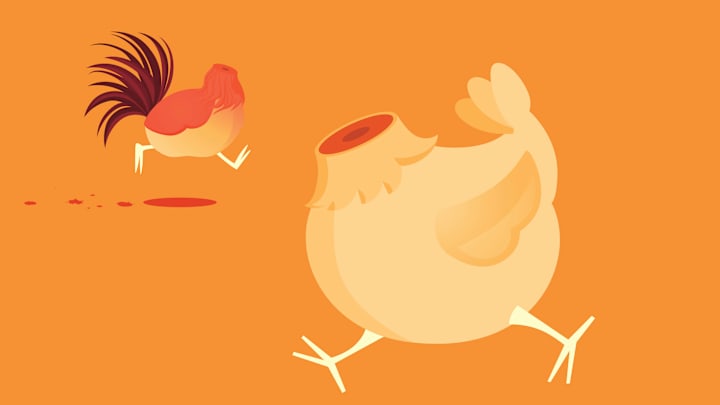If not for Lloyd Olsen’s desire to please his mother-in-law, Miracle Mike the Headless Chicken may never have existed.
It was September 10, 1945, and she was planning to join her daughter Clara’s family for dinner at their farm in Fruita, Colorado. So Olsen, knowing his wife’s mother had a predilection for fried chicken neck, took special care not to lop it all off when he beheaded the 4-month-old fowl.
But the skilled slaughterer accomplished his goal a little too well, leaving so much neck intact that after the two-and-a-half-pound Wyandotte rooster recovered from the initial shock of losing his head, he carried on as though everything were business as usual. This inexplicable survival spared him from ending up on the Olsens’ dinner table—instead of going back for a second blow, Olsen let him spend the night in an empty apple box on the porch. Come morning, the sightless bird still had yet to take his last breath.
Not Your Average Birdbrain
When Olsen loaded up his horse-drawn wagon with several dozen dead chickens to sell in town, he decided to take the lone survivor—which, at some point, was christened “Mike”—with him. The Olsens’ great-grandson, Troy Waters, told the BBC that Olsen then “started betting people beer or something that he had a live headless chicken.”
Mike didn’t remain a small town oddity for long. Olsen brought him to Salt Lake City, Utah, and showed him off at a press conference on September 19 with the help of Hope Wade, a local businessman.
“We’d go out every morning expecting to find him a dead chicken, but there he was, as healthy as could be, preening himself, trying to crow,” Olsen told reporters. “Perhaps Mike doesn’t even know his head is off,” Wade added. “Anyway, he’s worth more than $1.50 now.”
During the trip, University of Utah scientists studied Mike to find out exactly how he’d managed so long without a head. They determined that because Mike still had the majority of his brain stem—not to mention one ear, an unsevered jugular vein, and a clot that blocked blood from pouring from the wound—most of his necessary functions were unaffected.
Modern scientists have shed additional light on Mike’s miraculous survival. As University of Arkansas poultry physiologist and neurobiologist Wayne J. Kuenzel explained to Modern Farmer, chicken skulls contain huge holes for the eyes, forcing most of the brain to occupy the back of the skull at a roughly 45-degree angle.
“You’d be amazed how little brain there is in the front of the head of a chicken,” Tom Smulders, a chicken expert at Newcastle University’s Centre for Behaviour and Evolution, told the BBC. So even if you chopped off a seemingly sizable portion of a chicken’s head, there might still be enough brain left untouched for the creature to go on breathing, walking around, digesting food, and so forth.
As for how to give him food to digest in the first place, Olsen had worked that much out on his own. Mike’s esophagus functioned well, so his owner simply used an eyedropper to insert water, milk, and grain straight into it. Gradually, Mike grew to weigh almost 8 pounds.
Mike’s Big Break

What really facilitated Mike’s meteoric rise to fame was the decision to take him on the road as a sideshow act, charging 25 cents for admission. According to the BBC, it was Wade who dubbed the crownless wonder “Miracle Mike the Headless Chicken” and kept him on tour when the Olsens took breaks to tend their farm.
The death-defying rooster even spent some time in the Los Angeles area, where he dined on kernels of fresh yellow corn shipped straight from the Olsens’ farm. Wade, meanwhile, leaked whispers of a possible movie contract to the press.
By late October, Mike had received fan mail from Alaska to India, and LIFE magazine had devoted an entire article to him—complete with four pictures large enough to put you off your lunch. “Chickens do not avoid Mike, who, however, has shown no tendencies to mate,” one caption read. “Scab on neck has stopped bleeding.”
One Arba A. Gleen went so far as to pen a poem entitled “Miracle Mike the Headless Chicken,” whose third and final stanza closed with this upbeat couplet: “Although I haven’t got a head/I’m better off than if I’m dead!”
Fallen Fowl

Wade continued to parade the rare bird around the country until January 1947, when he returned him to the Olsens’ farm. With their pet in tow, the family set off for Phoenix, Arizona, to visit their daughter. It would spell the end for Mike’s brief, wondrous life.
One night, while the Olsens were sound asleep in their motel room, Mike began to choke. Though the noise did rouse his human handlers, they couldn’t locate the eyedropper (or syringe, depending on the account) fast enough to suction out the blockage. Within minutes, the beloved bird had passed away.
According to Waters, his great-grandfather just told people he’d sold Mike to a sideshow promoter, possibly to save him from having to “admit he screwed up and let the proverbial goose that lays golden eggs die on him.” As for whether the Olsens at least held a private burial for their feathered friend, Waters doesn’t think so. “I’m willing to bet he got flipped out in the desert somewhere between [Fruita] and Phoenix, on the side of the road, probably eaten by coyotes,” he told the BBC.
Fruita itself hasn’t been nearly as quick to let go of Mike’s legacy. In addition to erecting a sculpture in his likeness made of discarded metal tools, the town also founded an annual festival in his honor. The Mike the Headless Chicken Festival, held in late May or early June, typically features a 5K run, a disc golf tournament, a Peep-eating contest, and more.
